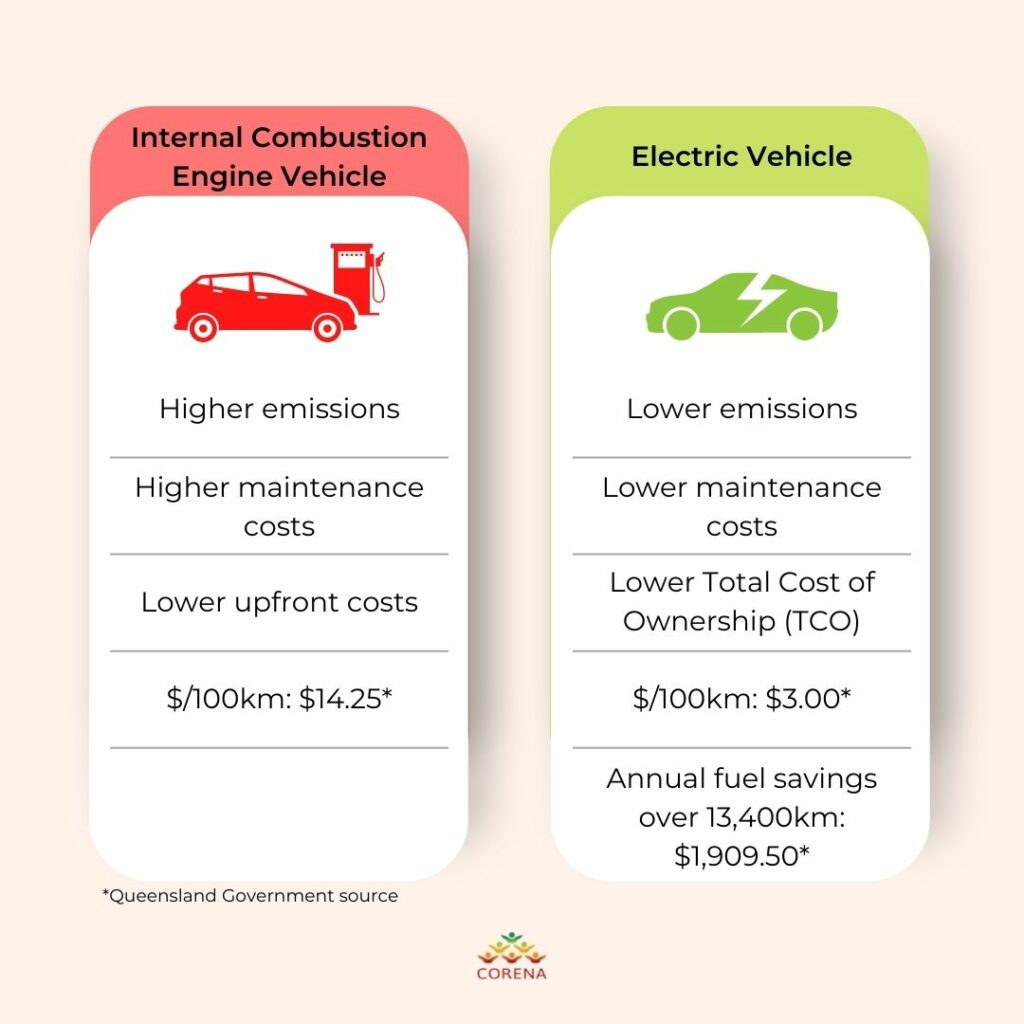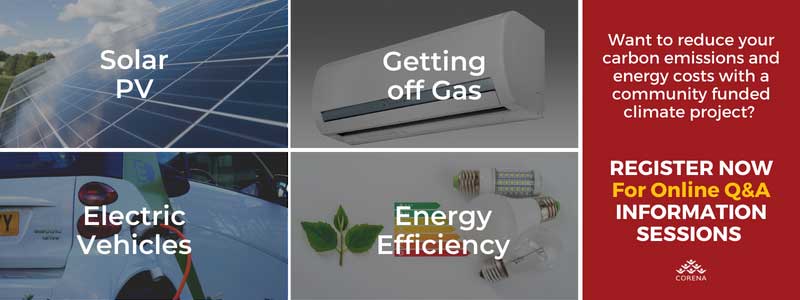Electric vehicles (EVs) have been attracting a lot of attention over the past few years and it is no surprise considering the many benefits they offer. Not only can they help you save money on your operational fuel costs, but also assist in reducing carbon emissions which is great for air quality and the planet as a whole! If you have thought about including an EV in your not for profit’s operations but don’t know where to start, CORENA can help!
CORENA works with a wide range of not for profits, social enterprises and community organisations, many of which have one or several vehicles as part of their operations. These might be delivery vans or trucks, vehicles for home visits or staff use or even buses for transporting clients.
Learn more in Commercial Electric Vehicles for Organisations
Like all new technologies it can take a little while for staff to get used to a new way of doing things but the benefits are huge. To assist, we have put together this electric vehicles guide for not for profits. Read on to learn some key facts and important information when deciding to go all-electric…
Why Drive Electric Vehicles?
Reports from governments, NGOs and private businesses across the world have unpacked the top benefits of driving an electric vehicle. These primarily include: decarbonisation, lower running costs, environmental friendliness in comparison to petrol and diesel vehicles, and better performance.
The main concerns registered by potential purchasers are higher initial cost, worry about the distance EVs can travel, also known as range anxiety, and the availability of places to ‘recharge’, especially in more remote areas, where longer-distance driving is more common.
However, these reasons for not buying an electric vehicle are often misunderstood. Going electric will benefit not just you, but the entire planet.
Learn more in 11 Electric Vehicle Benefits You Might Not Know About
Let’s now take a look at what electric vehicles are and how they differ from conventional cars and trucks…

What Is Meant By Electric Vehicle?
From the outside, petrol/diesel (also known as ‘ICE’, which stands for internal combustion engine) and electric cars are quite similar in appearance, but under the bonnet, where the engine can be found, is where the difference is. You may wonder why?
In EVs, motion energy is provided by the batteries and from there moves to an electric motor/s. In ICE cars, the energy source is the petrol or diesel in the fuel tank and goes to the internal combustion engine. Some cars, known as hybrid vehicles, combine both but we’ll only consider fully-electric EVs and compare them with ICE cars.
The Four Main Types Of Electric Vehicles
Battery Electric Vehicles
Battery electric vehicles are 100% powered by electricity and do not use any kind of fossil fuel whatsoever to function. The car’s large battery pack, which is charged by plugging it into the grid at designated charging stations or at home, powers the entire drivetrain.
The battery pack provides sufficient electrical charge to power a series of electric motors that propel the car. Battery electric vehicles are currently the preferred option owing to their low emission status and ease of maintenance.
Hybrid Electric Vehicles
Hybrid electric vehicles have been around for a while and use internal combustion engines in conjunction with a battery-powered motor. The benefit of a hybrid electric vehicle is that it does not need to be plugged into the grid to charge, as the petrol engine charges the battery when it is depleted.
These vehicles are more energy-efficient than vehicles with internal combustion engines. However, they are less efficient than battery electric vehicles as they still rely on an internal combustion engine as part of the means of driving the vehicle.
Plug-In Hybrid Electric Vehicles
Plug-in hybrid electric vehicles operate in a very similar manner to hybrid electric vehicles, except that the battery is not necessarily only charged by the internal combustion engine but can also be charged externally by plugging it into the grid.
They are generally considered more efficient than hybrid electric vehicles, but they are still less efficient than battery electric vehicles. Some plug-in hybrid electric vehicles burn biodiesel to increase their sustainability even further. However, it remains a less sustainable choice when compared to battery electric vehicles.
Fuel Cell Electric Vehicles
Fuel cell electric vehicles are a fairly new technology that makes use of hydrogen, in most cases, to drive the vehicle. They produce zero emissions, which makes them sustainable and environmentally friendly.
However, these vehicles are still pretty difficult to come by and can be challenging to refuel, owing to the general lack of fueling infrastructure for hydrogen-based vehicles. While these vehicles are attractive from a sustainability perspective, they are not yet widely available in Australia.
What Is The Actual Cost Of Owning An Electric Vehicle?
In general, the biggest concern when considering the purchase of EVs, is the greater initial cost of an EV in comparison to ICE equivalents. Why the greater expense? The main reason is battery price.
At the moment, it generally costs more to buy an EV rather than an ICE vehicle, but this is changing rapidly. When this article was written, battery costs on average were in the thousands of dollars and the price of batteries for the greatly publicised Tesla EVs was $20,000 to $35,000. Fortunately, though, battery prices are decreasing significantly and the initial cost of an EV and an ICE are forecast to become more-or-less comparable by 2027.
There are other considerations besides initial upfront purchase price. Over a car\’s life, the upfront cost comprises probably less than 50% of the total cost of ownership (TCO). To understand how much your car really costs, you must factor in ongoing costs such as fuel, depreciation, maintenance, insurance, and government charges as well. It costs much less to run an EV than it does to use petrol or diesel, particularly these days with skyrocketing fuel costs.
This means that over the vehicle’s life, an EV may cost less to own than its ICE counterpart. Because of this, the extra initial cost that you pay for an EV is often \’repaid\’ from the savings made when these costs are considered.
Electric Vehicles Lower Operating Costs
EV’s lower operating costs can primarily be attributed to their much lower costs of fuel and maintenance. For the same distance driven, EVs are far cheaper to charge than ICE cars are to fill up with petrol or diesel. An electric car costs approximately 90% less to charge and even less if you charge from your own solar panels. At the moment, petrol costs well over $2/litre in nearly all countries, electricity is vastly cheaper less prone to major fluctuations resulting from external factors, such as wars and supply chain problems.
Maintenance Of Electric Vehicle Vs Petrol
There is another very important consideration, EVs have much cheaper maintenance and service needs and costs. The cost of maintenance gets more with car age, the more you drive an EV the greater the saving, which reinforces the superiority of EVs in this respect.
EVs are much simpler machines than ICE vehicles. They have far fewer moving parts. Depending on your source, EVs have 20-200 moving parts. In comparison, an ICE car usually has 2000+. Simply, this implies less wear and tear and far less servicing and maintenance cost.
When you own an EV, things essential for the running of ICE such as spark plugs, radiators, valves, fuel tanks, exhaust systems, drive belts, clutches, hoses, etc are no longer necessary.
Over their lifetime, service and maintenance cost savings of electric vehicles will be approximately 10% to 30% lower.

Electric Vehicles Range
One of the main apprehensions that people have about EVs is that they can not drive as far as ICEs and that charging points are limited. While it is true that on average, EVs have a shorter range than ICE cars, many people often overestimate their day-to-day driving requirements. Despite contrary beliefs, modern EVs are able to drive 200km to 600km before needing to be recharged, which is well within the daily driving range required for most people.
Look at your actual driving requirements for your particular vehicles. CORENA worked with CERES Fair Food in Melbourne to assess the driving range they would require for their electric food box delivery services and found that even their longest delivery run would easily be covered by an electric van.
For an EV to work, most organisations will need to install their own chargers. CORENA assisted CERES Fair Food to find appropriate vehicle chargers that could charge their vans quickly and also utilise their excess solar power as much as possible.
If you think your staff may need to charge at times using public charging stations the numbers of public chargers are increasing rapidly. The Australian government recently announced a $250m investment in EV and low emissions vehicle charging infrastructure. You can see all the available chargers in your area on a website called plugshare.com.
Charging Times For Electric Vehicles
At the moment, charging an EV takes longer than filling a car. For most people who can charge at home or work, this is not a problem. A huge amount of research is being done throughout the world in order to speed up electric vehicle charging times. In recent news, there are now even EV batteries that can be charged in as little as only five minutes!
If you are considering EVs for your organisation think about how long they are parked at the office or depot and consider if these times could be used to charge the vehicles. During the day is ideal if you have solar panels but they can also be set to charge using a timer overnight to make the most of cheap off peak tariffs.
Learn more in How To Make The Most Of Your Solar Panels To Charge Electric Vehicles
How Long Do Electric Vehicle Batteries Last?
Another concern is the length of life of Electric vehicle batteries. This is a legitimate concern. EV batteries, like those in phones, degrade over time. This is to be expected. In ICE vehicles, there is ‘wear and tear’ on the engine, fuel, and transmission systems. In EVs, this relates to battery degradation.
An article from Australian carsales.com.au gave a very balanced commentary on this in 2019. Since then, there have been great improvements. In the USA, the manufacturers of EVs have to give a 100,000 km warranty for batteries. In Australia now, this is better as can be seen for Nissan, where there is now a 160,000km warranty.
Overall Environmental Cost
Sometimes EVs are referred to as zero-emissions transport as there is no carbon dioxide emission while the car is being driven. This is not really true. There are emissions associated with the manufacture of the vehicle as well as the generation of the electricity that is used. Life cycle assessment is an analysis technique used to assess environmental impacts associated with all the stages of a product\’s life from manufacture, use and disposal.
In Australia, it has been found that an electric vehicle currently emits, on average, 29-41% less emissions than a typical fossil-fuelled car for every kilometre driven over its life cycle. This depends on which state you live in and the particular energy generation mix in that state. Even better, while EVs currently emit significantly less carbon emissions, this will become even less as more and more renewable energy is connected to the grid. You can reduce carbon emissions even further by using solar power from your organisation’s own solar PV system.
Grants For Electric Vehicles
Australia is a country where EV ownership makes a lot of sense, not only does it have plenty of sunshine which could be harnessed in the future to charge EVs, a high proportion, 86%, of its population live in urban areas.
For a long time, the Australian Government was one of few in the developed world, which did not provide any worthwhile financial incentive for EV ownership.
Fortunately, this is changing and now there are very good financial incentives throughout the country from local, state and federal governments to assist with the uptake of electric vehicles as Australia transitions away from fossil fuel use and towards generating 100% renewable electricity.
Electric Vehicles Funding For Non-Profit, Community Organisations & Social Enterprises
An alternative to applying for grants for electric vehicles, if you work on behalf of a not-for-profit, community organisation or social enterprise, is what is known as a “revolving” climate fund. Here at CORENA We receive, record, and transparently report voluntary contributions from the public. We use that money to give interest-free loans to fund:
- Electric Vehicles
- Solar Panels
- Energy Efficiency
- Getting Off Gas – Replacement of fossil gas appliances with electric alternatives
- A combination of the above
You don’t pay any interest on your CORENA loan, and the quarterly loan repayments are set to be a little less than the savings on your operating costs averaged over a year. This means you are never out of pocket, but you don’t save much overall in the short-term. However, after your loan is fully repaid you reap the full financial benefit of having lower operating costs.
To learn more, check out how to apply for a loan, or register for one of our upcoming Online Q&A Information Sessions.


